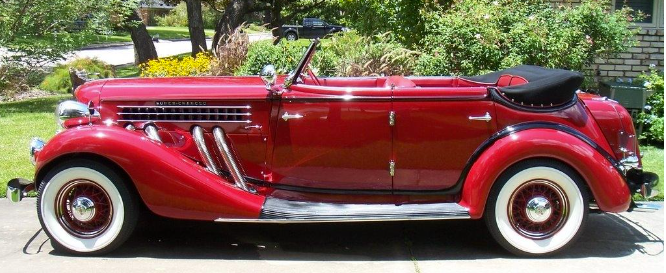
Featured Car on the Texas Tour- 1935 Auburn
A Texas Tour Veteran
By James Bartlett
If you’ve been on the Texas Tour in past years, you’re undoubtedly familiar with the red 1935 Auburn Supercharged Convertible Sedan owned by James and Eileen Bartlett of Tomball, just north of Houston. They’ve owned the car since 1994 and taken it on at least a dozen Texas Tours, plus AACA Glidden Tours around the country. The Auburn won the Most Popular Car award upon its debut in 1996, and over the years since a number of class awards. It also placed second in class in the tough Auburn-Cord Duesenberg club judging, as well as a first junior from the Classic Car Club.
The car has also been popular at local shows; the hot-rod crowd loves the external exhaust, polished aluminum engine parts and snazzy dashboard.
Auburns were upper-medium-priced cars that competed with Buicks and the cheaper Packards. Lacking the market presence and financial muscle of the larger integrated manufacturers, Auburn countered with cars that were jazzy, fast and bargains for the money. The Bartlett Auburn features a 150-horsepower engine, external polished stainless steel exhaust pipes, leather interior and a surprising amount of chrome for the art-deco era.
Only a few hundred of this model were made at just $1,750 each. One elderly AACA member told me that when he was in high school in the 1930s, “The supercharged Auburns were every kid’s dream,” largely thanks to the swoopy two-passenger Speedster model.
Our car was sold new in Baltimore, and remained with the original owner until its discovery by a collector in 1963. But there was a big problem. The car was stored for decades in a temporary metal building that eventually collapsed on top of the car, then funneled rainwater onto it.
That collector said, “When I pulled it out of the garage, the back half of the body fell off. I carried the car home in two pieces.” He performed a restoration that required building a new steel subframe for the body and welding patch panels into the doors and rear fenders. He farmed out the engine work. When finished, he took the car out to “see what she could do,” which was 85 miles per hour rather than the 100+ of which these cars were known to be capable. Disappointed, he sold the car, which went through two other owners before I bought it.
I re-restored the car in the mid-1990s with the help of my brother, Wayne Bartlett, who did at least half the work. We found that the super-charger was worn out and the aluminum cylinder head was porous and had leaked water into the engine, rusting out the valve seats. There was no compression, so the car wouldn’t run. Plus cosmetically, the ‘60s restoration didn’t meet modern standards. So we took the car all the way down to the frame and restored everything mechanical – engine, brakes, suspension, steering, two-speed shift mechanism, etc. We dipped and sandblasted the body, salvaged as much of the chrome as possible, and over a two-year span did a total ground-up restoration – excepting some of the engine specialty work mentioned earlier.
Luckily, there has always been sufficient interest in Auburns that suppliers of rubber bushings and custom castings still exist. Some years back I had a brand-new cylinder head cast for only $800 from the original factory molds, which are owned by a foundry operator who’s a member of the ACD Club. I more recently bought a long list of new rubber parts that have become available in recent years.
Given when we did the restoration, we used the paint we were familiar with at the time – acrylic lacquer, which is nearly idiot proof, and which unfortunately was already expensive at $700 per gallon in red even then.
In 2014 the car required a complete engine rebuild, which I had performed at a specialist shop in Detroit. Some of the best in the business are in the Detroit area, logical given its historic status as the capital of the U.S. automobile industry. In addition to the usual replacement of pistons, rings, valves and springs and crankshaft and cam bearings, the engine camshaft was worn out. So it was welded up and then reground to specifications. This cured a lingering heating problem and smoothed out the engine. That engine job cost $23,000.
Today, the car is a good 10-footer, considering its 30-year-old restoration that has covered at least 10,000 road miles. The paint is now beginning to go, with the shrinkage cracks common to aged lacquer, and places where the bondo repairs are also failing. But the Auburn still remains the best-driving of all my older cars, given its relatively light weight (3,800 pounds) which eases steering, and its good power and smooth-riding suspension.
We saw the Bartlett Auburn on the 2024 Texas Tour.